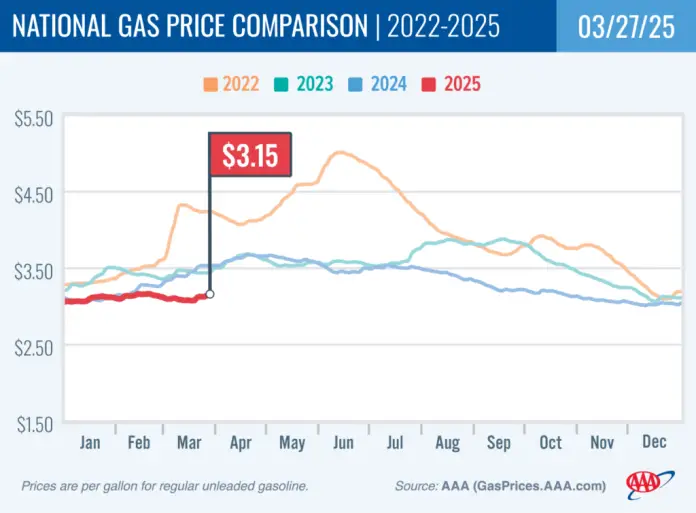As the spring season emerges, small business owners may find themselves facing an uptick in fuel costs, a dynamic that could shape their operational budgets and profitability. The national average price for a gallon of gasoline recently edged up 3 cents to $3.15, marking a seasonal increase typical for this time of year. However, it’s essential to note that prices remain approximately 40 cents lower than they were in 2024, largely due to current gasoline demand and crude oil prices.
According to the Energy Information Administration (EIA), gasoline demand fell from 8.81 million barrels per day to 8.64 million last week, and total domestic gasoline supply also decreased from 240.6 million barrels to 239.1 million. This drop in demand, coupled with lower gasoline production, which averaged 9.2 million barrels per day, could provide some relief for small businesses that heavily rely on driving, such as delivery services or transportation-related operations.
Although gas prices may be rising slightly now, the broader context shows that they have not skyrocketed as they might have in previous years. "Today’s national average for a gallon of gas is $3.15, which is 3 cents higher than a month ago and 38 cents lower than a year ago," an EIA spokesperson noted. Such statistics could play a critical role in how small businesses manage their transport and logistics operations moving forward.
In addition to traditional gas prices, small business owners with electric vehicles (EVs) should know that the average kilowatt-hour rate at public EV charging stations has remained steady at 34 cents. As businesses face fluctuating fuel costs, the stability of EV charging rates could offer some predictability for budgeting, especially if businesses are considering transitioning their vehicle fleets to electric.
The oil market dynamics also hint at potential future trends worth watching. Recent reports indicate that West Texas Intermediate (WTI) crude oil has seen an increase, closing at $69.65 per barrel, while U.S. crude oil inventories dropped by 3.3 million barrels. With current inventories about 5% below the five-year average, small business owners might want to prepare for continued volatility in both gasoline and oil prices as supply constraints could emerge.
Regional price disparities further complicate the landscape for small businesses. For instance, the highest gas prices are in states like California ($4.66) and Hawaii ($4.52), while states like Mississippi ($2.68) and Oklahoma ($2.72) boast significantly lower costs. Being aware of these regional variations can help business owners plan logistics more effectively, identifying opportunities to save on fuel expenses by modifying delivery routes or encouraging remote work where applicable.
Bright spots exist, such as the current stability in the price of electric vehicle charging in various states. Kansas and Missouri rank among the lowest in public charging costs, while Hawaii and West Virginia are at the top of the list for higher rates. Understanding these differences can help small business owners make informed decisions about their investments in green technology and transportation.
As spring progresses, small business owners should remain proactive in managing their fuel costs. Utilizing resources like the AAA TripTik Travel planner, which provides current gas and electric charging prices along routes, can ease some of the uncertainty. By keeping an eye on both gasoline and electricity prices, owners can better navigate the financial implications of fuel expenses in their operations.
In summary, while small businesses can expect to see an increase in gas prices as spring unfolds, careful monitoring of market dynamics and regional differences can help them mitigate costs. The overall trend toward cheaper gas compared to last year offers a bit of relief, but vigilance will be key to maintaining profitability during this season of changing fuel prices. For more detailed insights and real-time updates, visit the full report at AAA.
Image Via Gas Price



